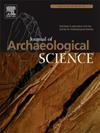海洋的意义:历史切萨皮克湾生态系统中硫同位素的变化
IF 2.5
1区 地球科学
Q1 ANTHROPOLOGY
引用次数: 0
摘要
稳定硫同位素(δ34S)分析是解决有关饮食和迁移的考古和生态问题的重要工具。越来越多的工作强调了δ34S在追踪与特定水生初级生产相关的食物来源方面的价值,包括盐沼、淡水湿地、海草床和底栖微藻群落。相对而言,研究其他海洋脊椎动物食物网δ34S变化的工作较少。这可能反映了普遍的假设,即同位素均质的海洋硫酸盐将是所有海洋生态系统中消耗δ34S的主要贡献者。我们通过对来自前工业时代背景下詹姆斯敦考古遗址的海洋动物的骨骼胶原蛋白的δ34S, δ13C和δ15N分析来探索这一假设,詹姆斯敦考古遗址位于今天弗吉尼亚州切萨皮克湾附近。结果显示,大多数分类群的δ34S值与基于物种海洋生态的预期值存在差异。底栖生物初级生产作为硫化物影响的载体,低δ 34s硫进入水生食物网,提供了最简洁的解释。这些发现所代表的生态多样性,涵盖了广泛的海洋和河口生境,表明这种现象可能在底栖藻类构成全球河口和其他沿海生境初级生产的重要组成部分的地方很普遍。讨论了考古和生态δ34S解释框架的意义。本文章由计算机程序翻译,如有差异,请以英文原文为准。
What it means to be marine: Sulfur isotope variability in the historical Chesapeake Bay ecosystem
Stable sulfur isotope (δ34S) analysis is an important tool for addressing archaeological and ecological questions about diet and mobility. A growing body of work has underscored the value of δ34S for tracing food sources linked to specific kinds of aquatic primary production, including saltmarshes, freshwater wetlands, seagrass beds, and benthic microalgal communities. Comparatively little work has investigated δ34S variation in other marine vertebrate food webs. This may reflect prevailing assumptions that isotopically homogenous marine sulfates will be the main contributor to consumer δ34S in all marine ecosystems. We explore this assumption through δ34S, δ13C, and δ15N analyses of bone collagen from a taxonomically and ecologically broad cross-section of marine fauna from preindustrial contexts at the archaeological site of Jamestown, near the Chesapeake Bay in present-day Virginia. Results for most taxa show δ34S values that diverge from those expected based on species’ marine ecologies. Benthic primary production, serving as a vector for sulfide-influenced, low-δ34S sulfur entering aquatic food webs, offers the most parsimonious explanation. The ecological diversity represented in these findings, covering a wide range of marine and estuarine habitats, suggests that this phenomenon could be common where benthic algae form an important part of primary production in estuarine and other coastal habitats across the globe. Implications for archaeological and ecological δ34S interpretive frameworks are discussed.
求助全文
通过发布文献求助,成功后即可免费获取论文全文。
去求助
来源期刊

Journal of Archaeological Science
地学-地球科学综合
CiteScore
6.10
自引率
7.10%
发文量
112
审稿时长
49 days
期刊介绍:
The Journal of Archaeological Science is aimed at archaeologists and scientists with particular interests in advancing the development and application of scientific techniques and methodologies to all areas of archaeology. This established monthly journal publishes focus articles, original research papers and major review articles, of wide archaeological significance. The journal provides an international forum for archaeologists and scientists from widely different scientific backgrounds who share a common interest in developing and applying scientific methods to inform major debates through improving the quality and reliability of scientific information derived from archaeological research.
 求助内容:
求助内容: 应助结果提醒方式:
应助结果提醒方式:


